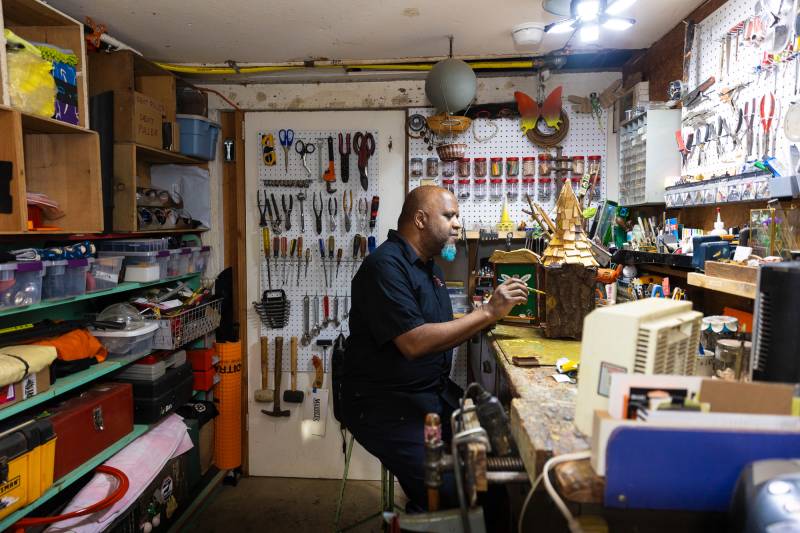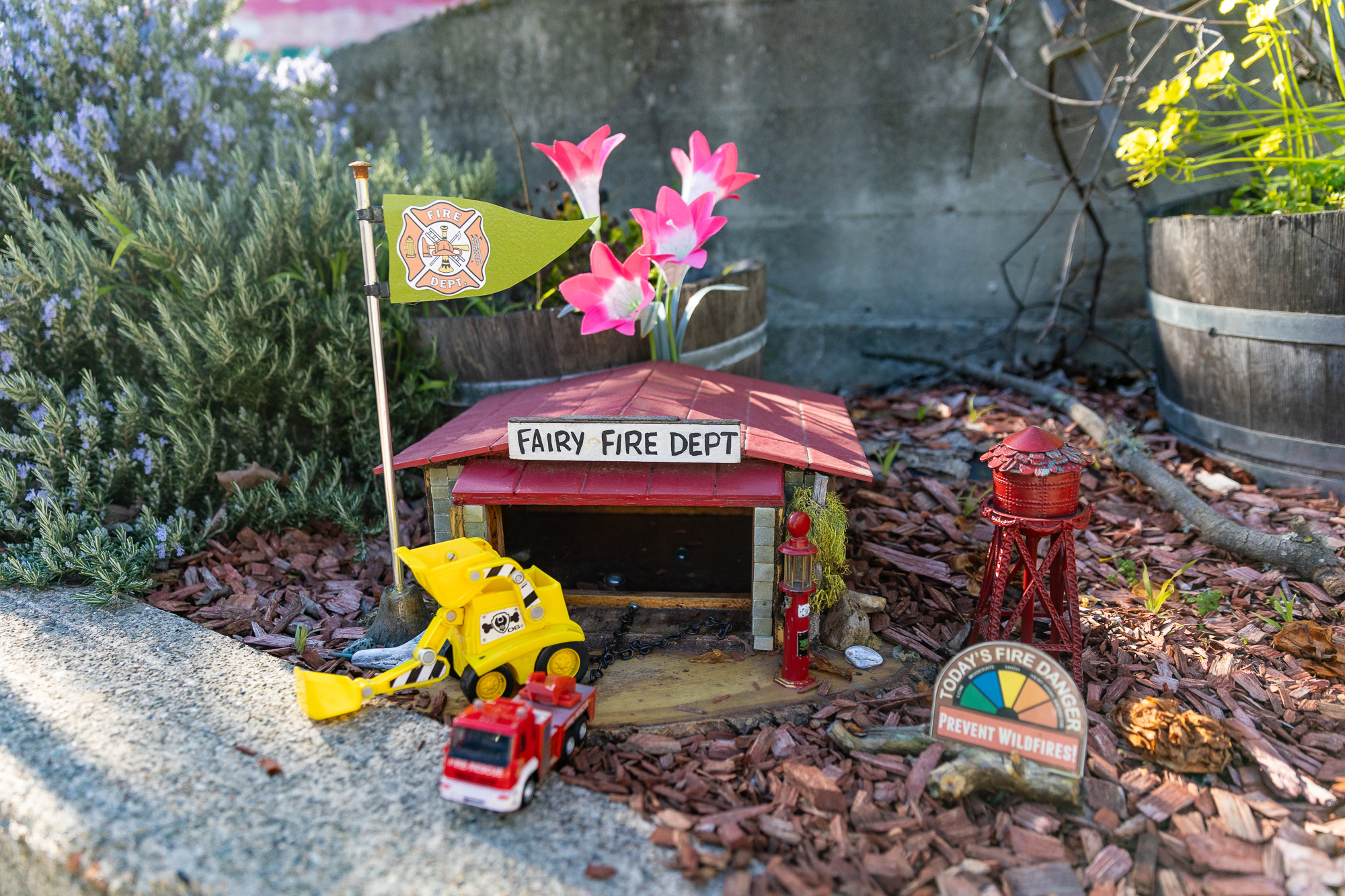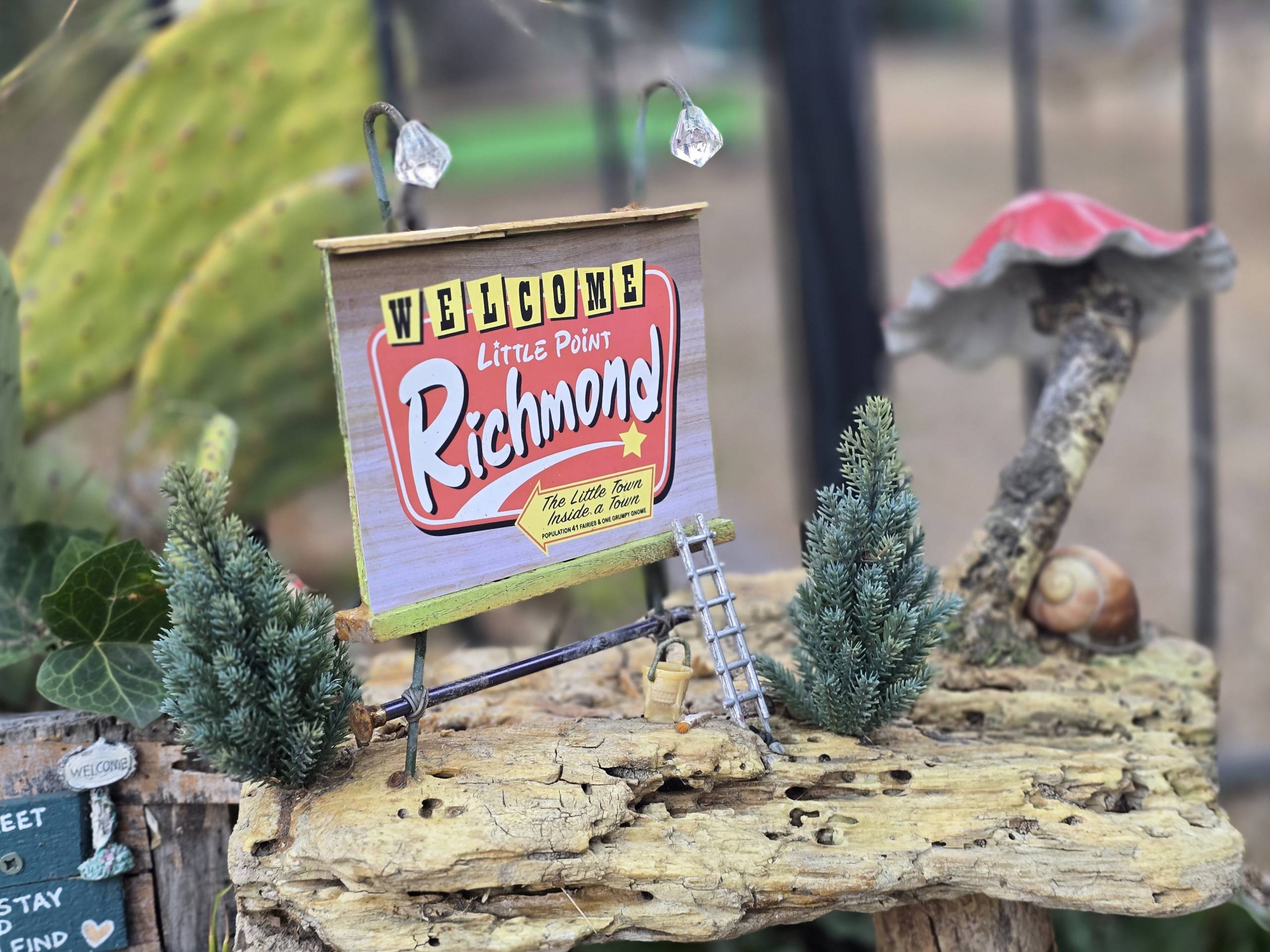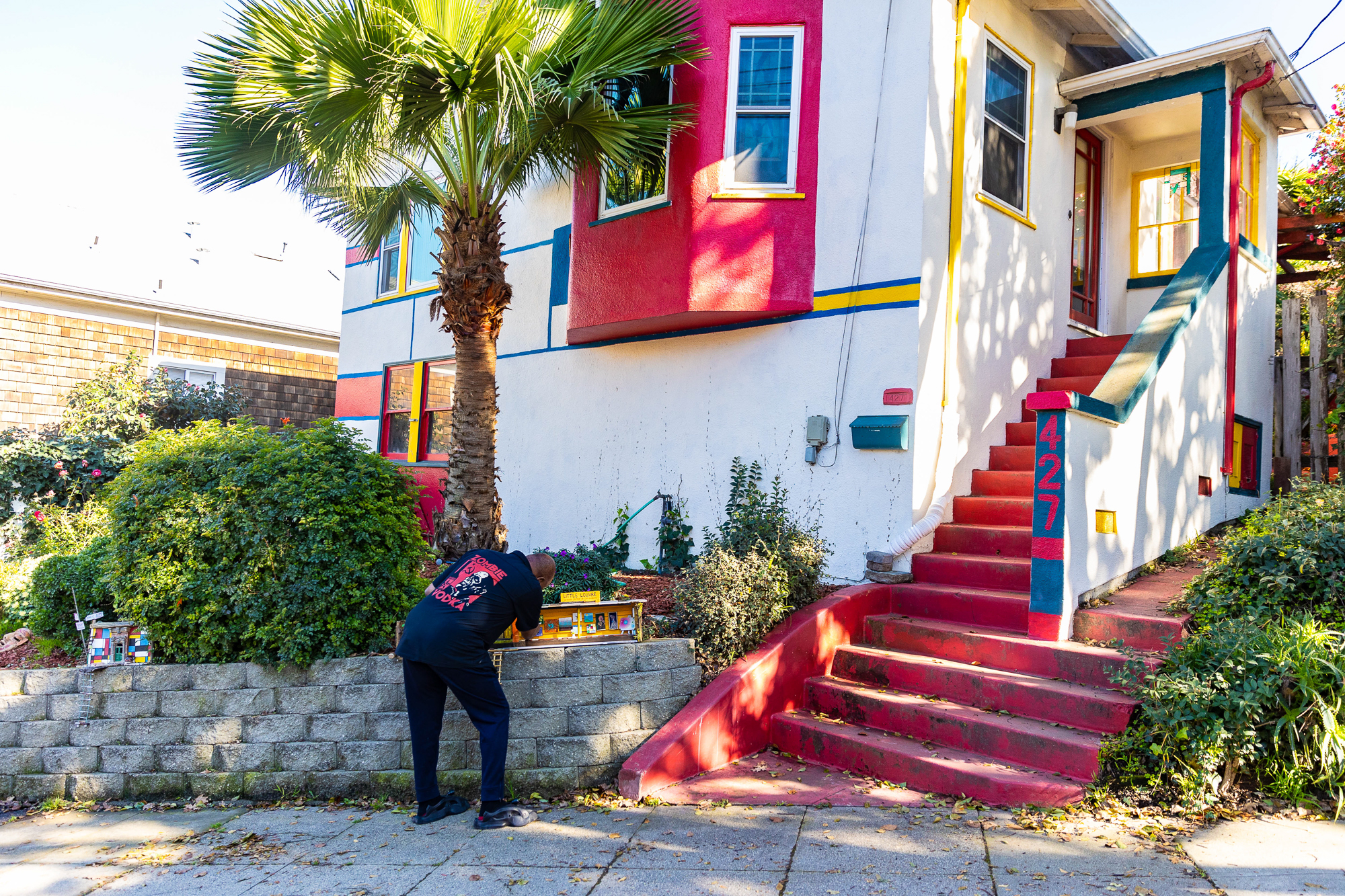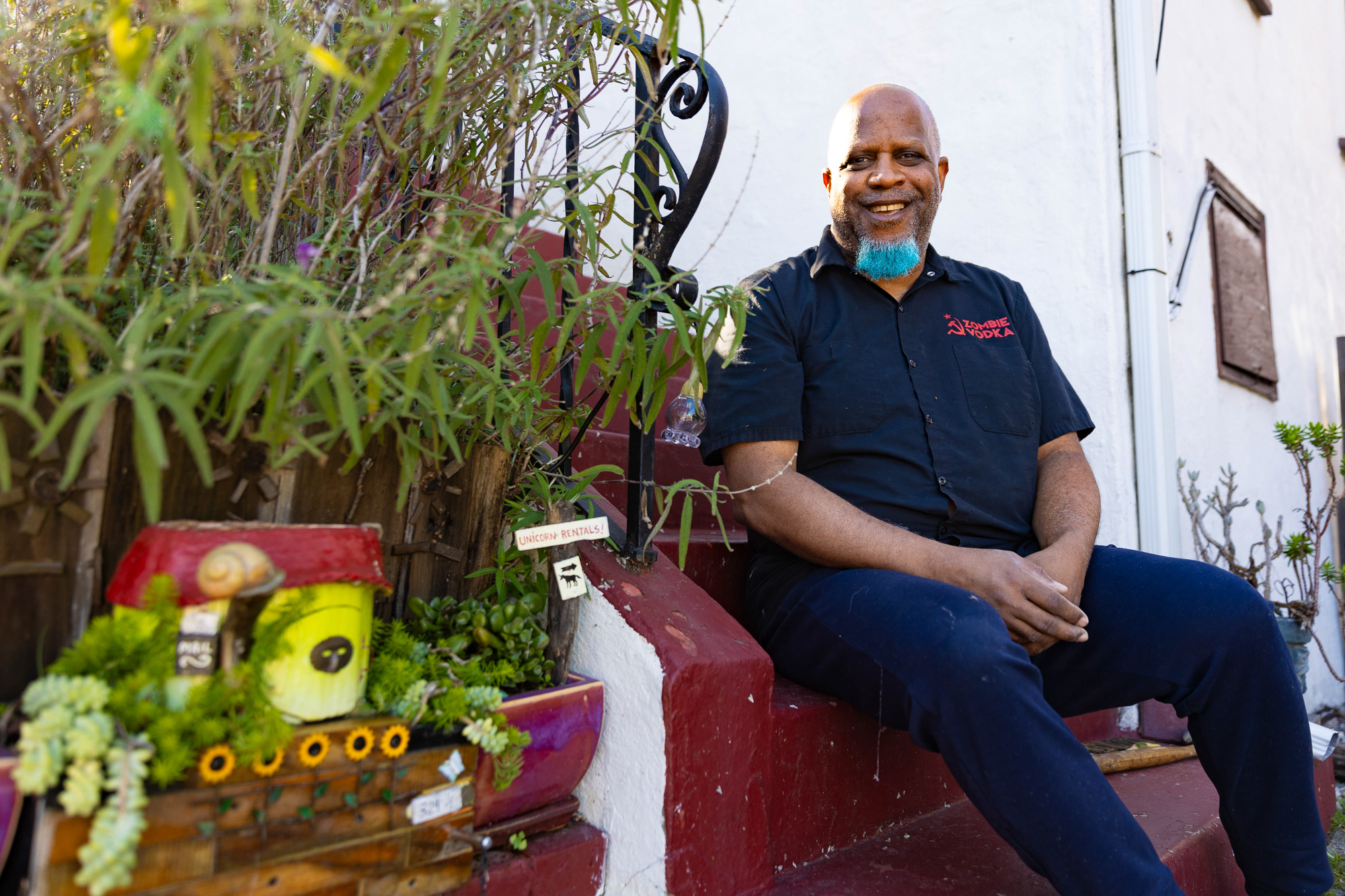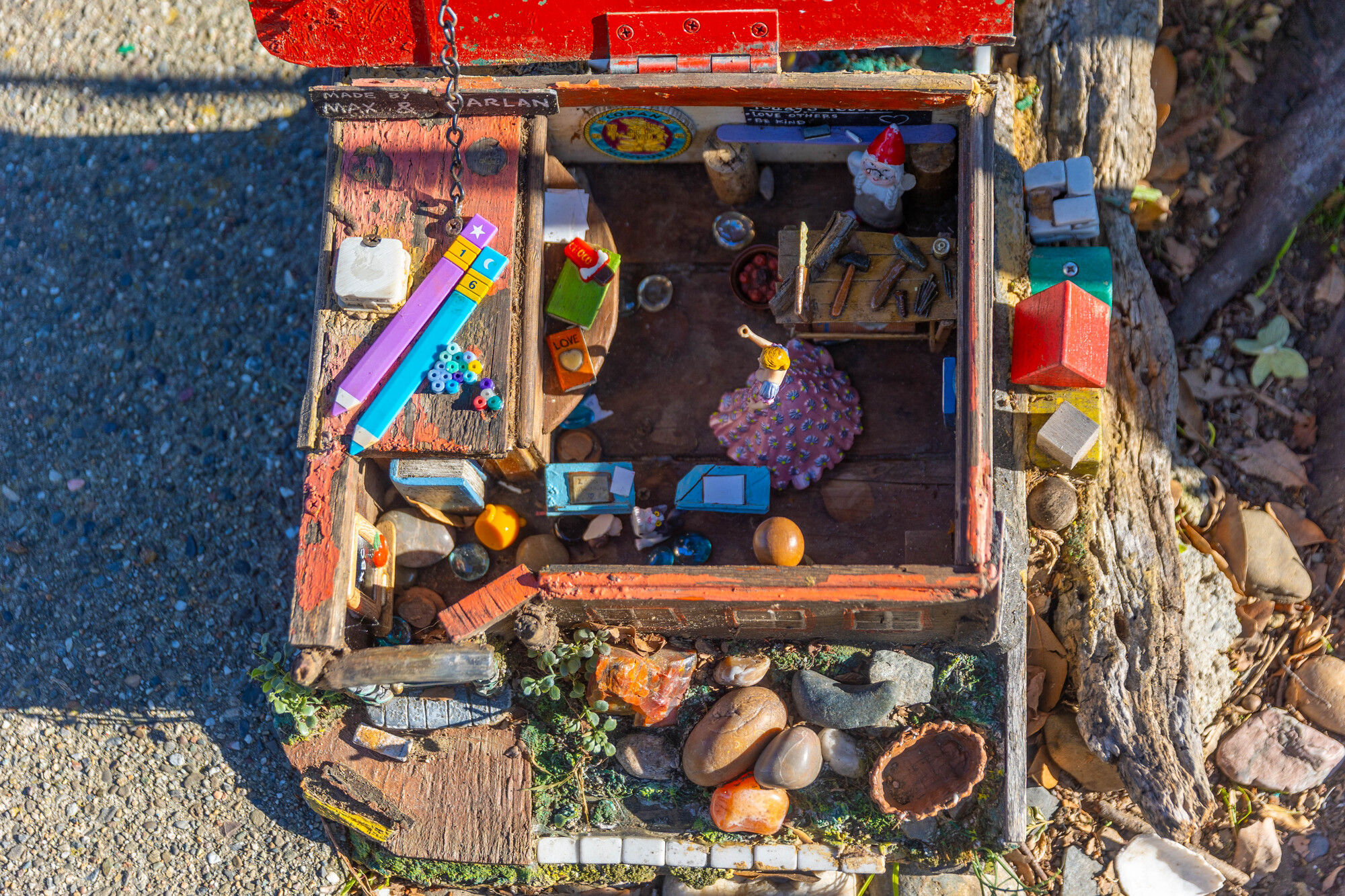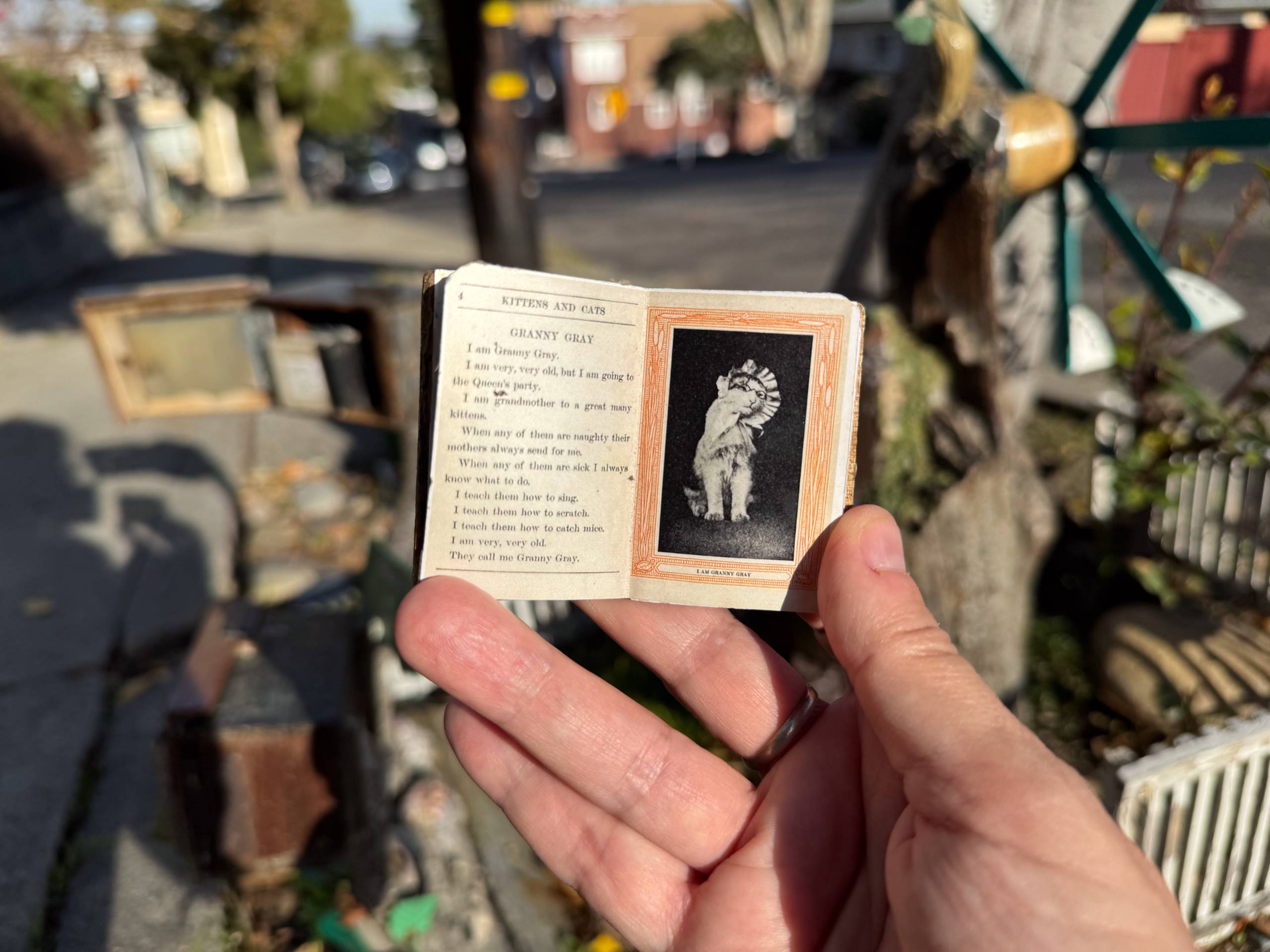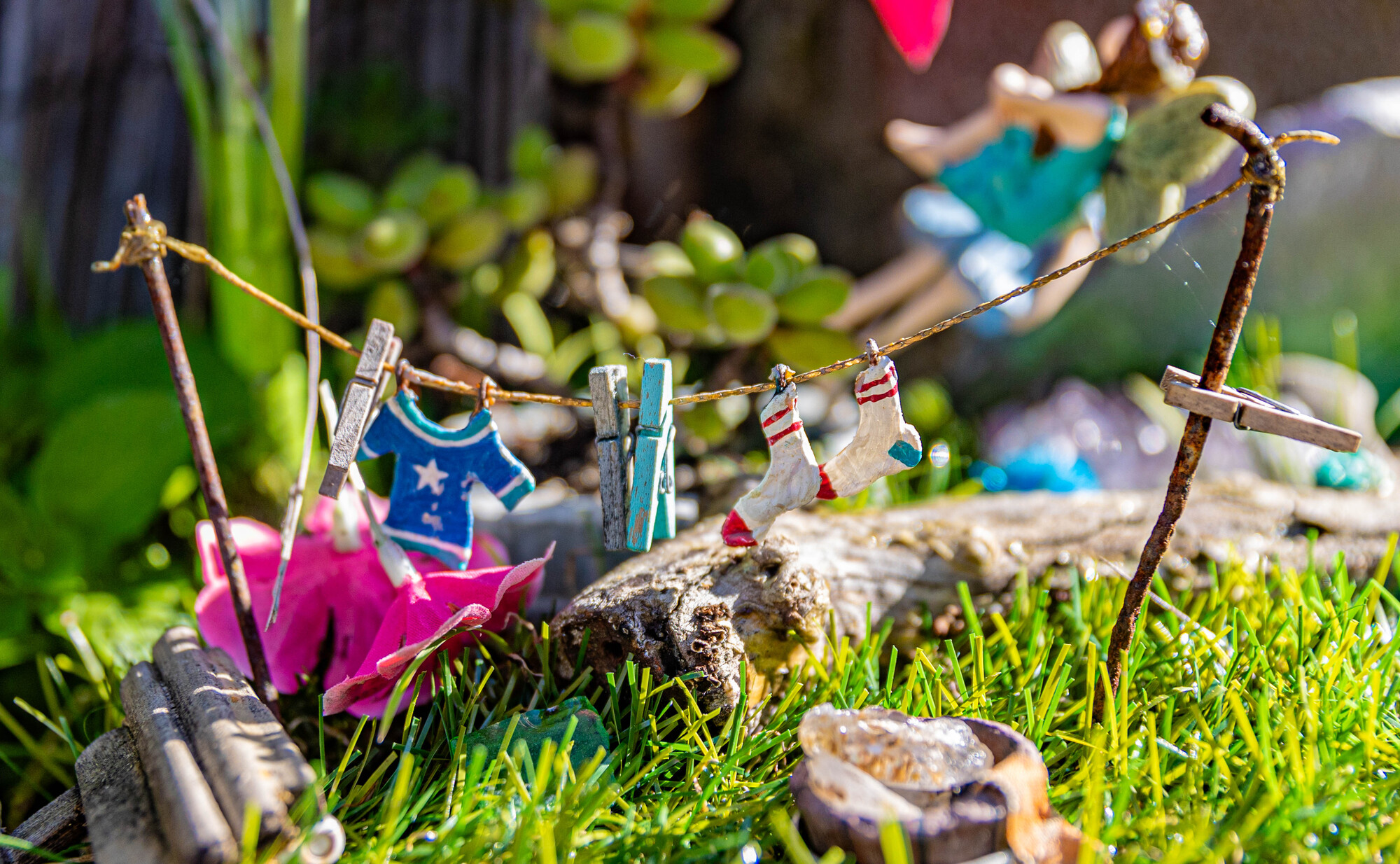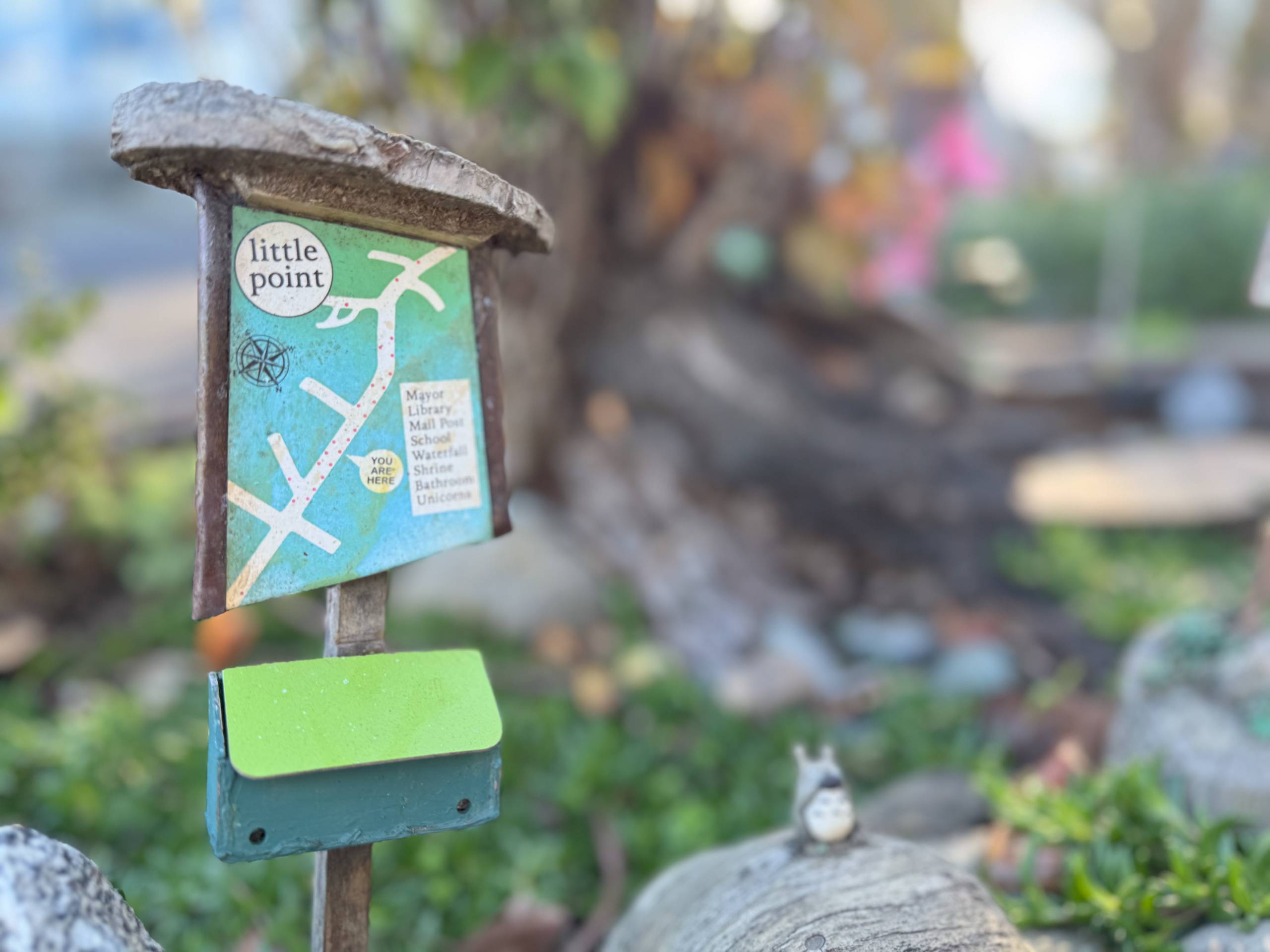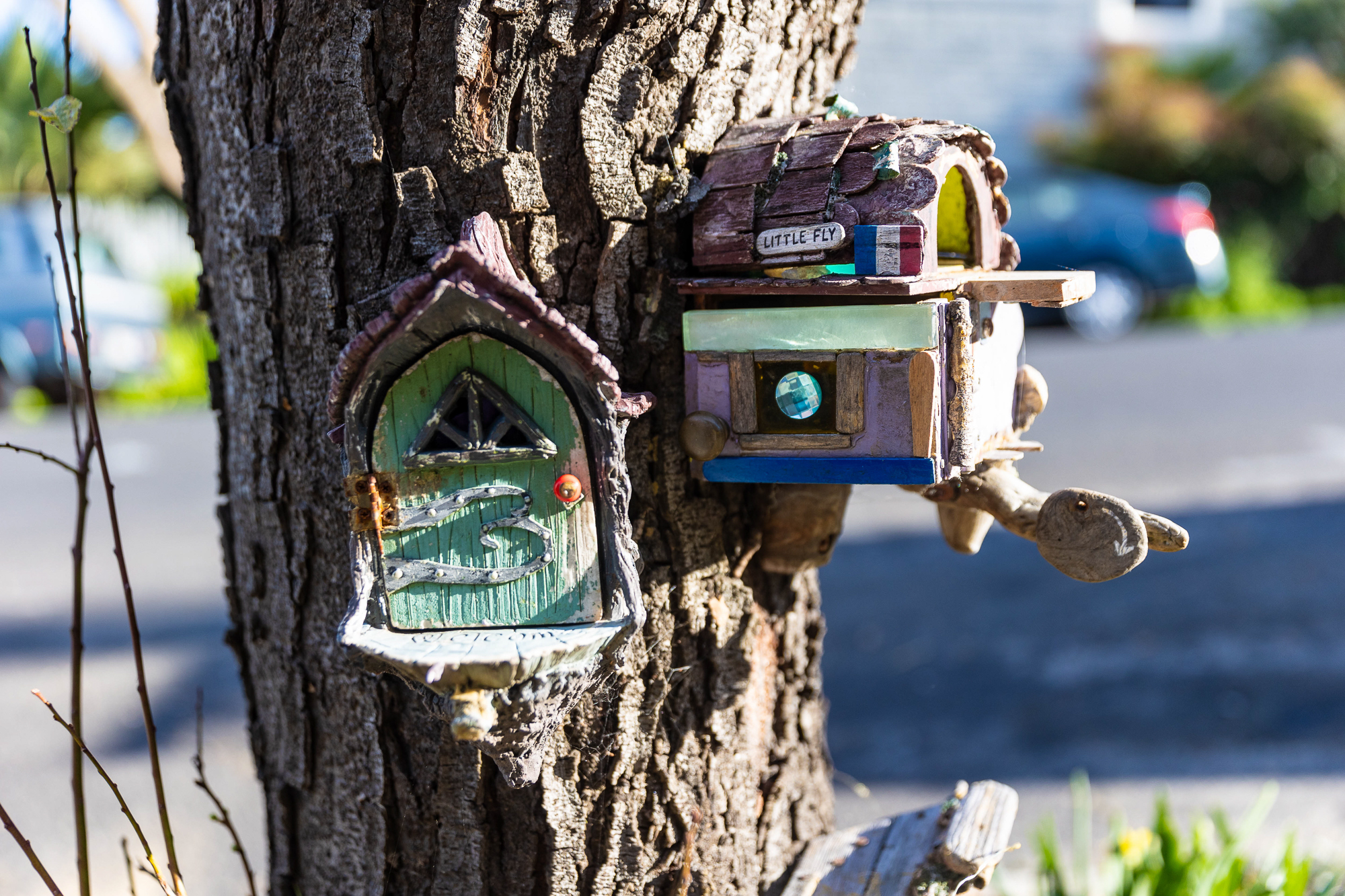Episode Transcript
This is a computer-generated transcript. While our team has reviewed it, there may be errors.
Olivia Allen-Price: Hey everyone, I’m Olivia Allen-Price. And this is Bay Curious, the show that answers listener questions about the San Francisco Bay Area.
Today’s show takes us to the city of Richmond where something magical is happening within the small bayside neighborhood of Point Richmond. That’s where a Bay Curious listener, who also happens to be a KQED employee, Laura Benitez lives. She was on a stroll with her toddler, passing the local fire station when…
Laura Benitez: Next to the fire station, there was a tiny fairy house fire station. And it was just the cutest thing. And she played with it for like half an hour. And I then kind of heard from other people in the neighborhood that there was a whole series of fairy houses.
Olivia Allen-Price: Sprinkled all up and down Washington Street you’ll find more miniature homes and the public services to support them. They’re all brimming with the personality of their imaginary fairy inhabitants and highly detailed.
The wee buildings have been dubbed “Little Point Richmond” and Laura loves them.
Laura Benitez: I appreciate all things whimsical and artistic and those little things that make life more meaningful.
Olivia Allen-Price: But she wants to know: where did this little fairy amusement park come from? Who is behind it?
Today on the show we explore some of the hidden treasures you’ve been wondering about as you explore your neighborhoods. We’ll start in the tucked away community of Point Richmond in the East Bay and then make our way to Golden Gate Park in San Francisco to visit a very green waterfall. Stay with us.
Sponsor break
Laura Benitez: Scattered across the Point Richmond neighborhood are dozens of intricate fairy houses. KQED reporter Pauline Bartolone set out to discover who is behind them all.
Sounds of kids running
Kid 1: “Oh I found something!”
Pauline Bartolone: Every time my five year old daughter and I go to Little Point Richmond, there’s something new to explore. On a recent Saturday with one of her buddies it felt like we were on an easter egg hunt.
Kid 2: Over here!
Pauline Bartolone: At least thirty magical creations, in all shapes and colors, flank the sidewalks. Some are hidden under branches, others are on the ground in plain sight.
Kid 1: Ahhh! Fairyhouse…
Kid 2: Ah… there’s too many of them…
Pauline Bartolone: They jut out from tree trunks, or perched on stumps and concrete walls. When found, they’re a total delight.
Kid 1: Another fairyhouse… Pretty…
Kid 2: Let’s go!
Pauline Bartolone: They’re like tiny dollhouses made of gourds, popsicle sticks, or sawed-off baskets. Each has their own theme.
Kid 2: We gotta ring the bell!
Pauline Bartolone: And there’s plenty to interact with… windchimes, marble slides…
Kid 2: See how it goes?
Sounds of a bell ringing and a marble rolling down a shoot.
Pauline Bartolone: Open up a tiny door and you’ll peak into a miniature world of whimsy. Furniture crafted with found things, like a stool made with a bottle cap. You’ll find a one inch salmon dinner and thumbnail-sized mailboxes. The scenes make these preschoolers bust out into song.
Kid 1 singing: Go on the bench and go in your cozy fairy house and sit on your little chair. Close the fairy house house and you’re all ready now.
Pauline Bartolone: Just a few minutes of playing with the wee dwellings inspire deep questions:
Kid 2: Who made these?
Pauline Bartolone: Neighbors say the fairy houses just pop up like mushrooms after a good rain. But there is indeed one artist behind them, who so far has been pretty elusive.
Jimmie Robinson: I’ve been hiding for so long (laughs)
Pauline Bartolone: Jimmie Robinson. He’s a professional illustrator and successful comic book artist. He lives on the street with all the fairy houses, but he doesn’t sign his works. And this is the first time he’s publicly spoken about being the fairy house creator.
Jimmie Robinson: Just here in the basement is my little workshop of sorts.
Pauline Bartolone: Call it social anxiety, or maybe humility, Jimmie prefers the work space underneath his house over being seen outside with his creations.
Jimmie Robinson: I do not want the spotlight. This is true. I wanted people to see the fairy houses, but not see me.
Pauline Bartolone: Jimmie says this public art project, it all started about eight years ago. On a wall outside his own house. All the flowers had died in one of his planter boxes.
Jimmie Robinson: I put this little tiny garden shed, like a gnome garden shed there as if, you know, “Hey, I’m working on new flowers. Don’t worry.” And the flowers never came back, but I just kept building off of the garden shed. So made a little pathway for it. And then a house for the garden shed. People would stop and look at it and it was funny. That’s where it all started.
Pauline Bartolone: Then he built one for his neighbor. And then another one. He’s friendly with people on the block so he knew enough about them to cater his creations to their specific jobs and interests.
Jimmie Robinson: So I already knew that Rosa was a librarian, that, you know, that Aveline was from France.
Pauline Bartolone: He says some of his neighbors are touched when fairy houses pop up in their yards.
Jimmie Robinson: You know, Tien, she’s from Laos, she’s Laotian and when I did the Laotian flag and I researched how to make the numbers. And so I did them in their native language and they were just like, they’re bringing all their friends and neighbors and family over to see it.
Pauline Bartolone: But most of the time, he doesn’t see their reactions. Because he’s often putting the houses up at night, when no one is looking.
Jimmie Robinson: I do get notes. I get letters. I get stuff left in the mailbox.
Pauline Bartolone: Little Point Richmond became more of a town for fairies a few years ago when Jimmie started crafting mini public services. There’s now a fire station, a post office, a school and a little library, with yes, miniature books and pages to turn.
It takes Jimmie about a month to craft a fairy dwelling. But each project is different.
Jimmie Robinson: And I’ll be down here six hours a day, all day, or barely at all.
Pauline Bartolone: Jimmie says he’s always been a tinkerer, back to when he was growing up in Oakland.
Jimmie Robinson: I’m an only child. My mom’s very creative herself as a seamstress and so I didn’t have brothers and sisters to play with. I had to create worlds. I had to imagine my own places, uh, or build things that had a story as well.
Pauline Bartolone: He says building fairy houses is different from his two-dimensional work as an illustrator. With comic books, he completes the story for the reader. But fairy houses invite people to imagine their own stories.
Jimmie Robinson: Fairy houses are open ended. They’re, you know, open for interpretation and all that. There’s no figures. There’s just the house. You don’t know what it does, what lives there, how it lives, what it eats, what it does.
Jimmie Robinson: Ooh, this one’s going to need some work.
Pauline Bartolone: On a walk down the fairy house street, Jimmie shows me all the things people add to the houses.
Jimmie Robinson: Oh, yeah. See somebody’s added a bunch of stuff here.
Pauline Bartolone: People leave a lot of fairy figurines, of course, but unexpected treasures show up too.
Jimmie Robinson: Yeah, there’s salamanders and little glass rocks and pebbles and a candy wrapper. There’s a little nut back there.
Pauline Bartolone: Jimmie has to make a lot of repairs to these little worlds…he checks on them once a week. But the way visitors interact with them gives him new ideas, too. …Like the marble slide.
Jimmie Robinson: I was finding marbles, they were part of this little landscape and the thing was the kids would mess with them and the marbles would roll down the hill. And so that’s when I came up with making my own marble run.
Pauline Bartolone: Jimmie says, Little Point Richmond is all about inclusivity.
Jimmie Robinson: The houses aren’t just for fairies — gnomes and insects can live here too.
And to be a fairy tourist, you don’t have to be a kid. In fact, lately, people of all ages come by the bus load. It’s on Google Maps.
Jimmie Robinson: My intention with the fairy houses is to make an environment that you can walk into an interactive experience. That’s what I want. I don’t care if it’s a kid or adult or whatever or my neighbors. It is you’re walking into an area that’s now Little Point Richmond.
Pauline Bartolone: The latest addition to the neighborhood? A mini Louvre, as in the French national art museum, where visitors can contribute bite-sized works of art.
Olivia Allen-Price: That was KQED reporter Pauline Bartalone. She first reported on the fairy houses for Craftsmanship Magazine. Thanks also to Eli Rosenberg.
Those fairy homes are quite the draw for kids. We’re currently working on an episode about other kid-friendly places and activities in the Bay Area and we want to hear from you. If you have kids in your life, what are some of your favorite places to have fun? Whether it’s a business, outdoor space, cultural center or an offbeat hidden gem — we want to hear about it and why you love it. Use your phone to send a voice memo to baycurious@kqed.org or leave us a voicemail. Just call 415-553-3334.
Next up we’re heading across the Bay Bridge to San Francisco’s Golden Gate Park where another listener question is waiting for us.
Persie Nakonechny: I’ve lived in San Francisco for over 30 years but my husband and I moved to the Richmond district a couple of years ago and during COVID, it was awesome to get out into the park and be around other people, but at a distance.
Olivia Allen-Price: This is Persie Nakonechny.
Persie Nakonechny: That’s when we really took a closer look at a lot of the little hollows, the museums, the little areas that are made, you know, just for people to enjoy and hang out.
Olivia Allen-Price: There’s one particular feature in Golden Gate Park that Persie has wondered about whenever she passes it. Rainbow Falls… a man-made waterfall on John F. Kennedy Promenade near Crossover Drive.
Persie Nakonechny: the water at Rainbow Falls and the creek that runs from it into Lloyd Lake is sometimes an alarming shade of green. with a weird foam. I’m not sure if it’s algae or an attempt to stop people from being tempted to drink it or something else.
Olivia Allen-Price: We passed this one along to KQED editor Chris Hambrick.
Sounds of a stream gurgling, birds singing, wind
Chris Hambrick: I had to see this green waterfall for myself. Even though it’s man-made, the area is serene with trees, tall grasses and bushes bordering the lake. I even saw a few ducks.
Chris Hambrick in tape: Time to hang out with the ducks. (Sounds of wings flapping)
Chris Hambrick: This spot used to be a quarry. Many of the original roads in Golden Gate Park were built with rock from here. When the quarry closed, neighbors wanted something beautiful and Park Superintendent John McLaren listened. The Falls opened in 1930. General Electric lit up the water with multicolored lights for the dedication, thus the name “Rainbow Falls.”
The lights don’t work nowadays, but both the waterfall and the pool below it are green, bright green. I talked to someone who can tell me why.
Dave Iribarne: My name is Dave Iribarne. I’m the superintendent of Golden Gate Park for the San Francisco Recreation and Parks Department.
Chris Hambrick in tape: What color would you call this green?
Dave Iribarne: I would say it’s definitely neon green with a hint of lime.
Chris Hambrick in tape: What causes water in this lake and the corresponding falls to be this shade of green?
Dave Iribarne: Basically, it’s just a natural algae bloom. it’s just an alarming shade. So it kind of freaks people out, but there’s really nothing harmful about it.
Chris Hambrick: Dave tells me that the shade of green changes depending on what’s going on with the algae, and today when I arrive, I see that he and his crew are draining the falls for maintenance.
Dave Iribarne: We’re right now in the process of, uh, installing aeration in Lloyd Lake, which feeds Rainbow Falls. And then we’re going to put some flocculant. It’s like a powder that gets poured in, and it actually grabs onto the algae and weighs it down and sinks it down to the bottom so that it can’t keep reproducing.
Chris Hambrick: To help control algae growth, they also add in some microbiotics, which are living organisms that actually feed on the algae.
Dave Iribarne: And then we put in a dye, like a green dye. It’s pretty unnatural looking. We have it in many of our lakes in the park. But the dye prevents the sunlight from feeding the algae.
Chris Hambrick in tape: Okay, but it is like for sure for sure it’s the algae that causes this color.
Dave Iribarne: 100 percent it’s the algae that causes the color.
Chris Hambrick in tape: That’s so interesting.
Dave Iribarne: Yeah, we’re actually getting ready for St. Patrick’s Day. So, you know, we just dye it green. Just kidding.
Chris Hambrick: I take all this info back to Persie to see what she thinks.
Persie Nakonechny: So that’s natural. And maybe the change in the color would make sense to that, like in the summer, when there’s more sunlight that it’s growing more, and that’s why it turns that fluorescent green. It’s so funny to me that it’s a natural substance. But nature’s weird.
Chris Hambrick: Indeed, it is.
Olivia Allen-Price: That was KQED editor Chris Hambrick.
Bay Curious is made in San Francisco at member-supported KQED.
Our show is produced by Katrina Schwartz, Christopher Beale, and me, Olivia Allen-Price.
Extra support from Jen Chien, Katie Sprenger, Maha Senad, Alana Walker, Holly Kernan and everyone at team KQED.
I’m Olivia Allen-Price, have a great week.
